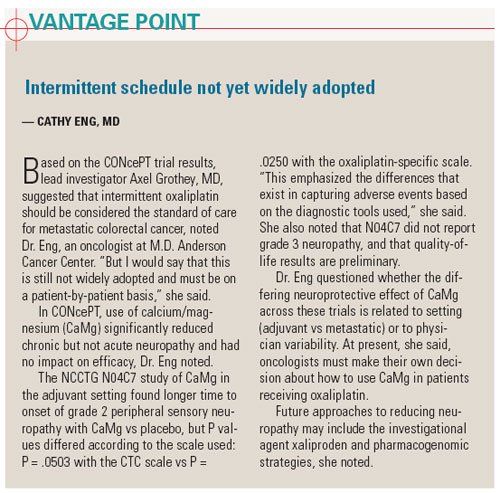Calcium-magnesium is neuroprotective in patients receiving oxaliplatin
The combination of intravenous calcium and magnesium salts (CaMg) is associated with a nearly one-half reduction in the rate of chronic oxaliplatin (Eloxatin)-induced sensory neurotoxicity among patients receiving adjuvant FOLFOX therapy for colon cancer, compared with placebo.
ABSTRACT: Despite early discontinuation, trial finds rate of chronic oxaliplatin-induced sensory neurotoxicity is reduced by almost half in the adjuvant colon cancer setting.
The combination of intravenous calcium and magnesium salts (CaMg) is associated with a nearly one-half reduction in the rate of chronic oxaliplatin (Eloxatin)-induced sensory neurotoxicity among patients receiving adjuvant FOLFOX therapy for colon cancer, compared with placebo.
“Peripheral sensory neurotoxicity is the dose-limiting toxicity of oxaliplatin,” said lead author Daniel A. Nikcevich, MD, PhD, medical director of the Duluth Clinic Cancer Center in Minnesota. “This neurotoxicity frequently leads to early discontinuation of oxaliplatin-based therapy, in both the metastatic and adjuvant settings.”
Research suggests that this toxicity occurs because oxaliplatin chelates calcium, impairing the function of sodium channels on neurons, he explained.
In the phase III, double-blind trial (NCCTG N04C7), patients with resected stage II or III colon cancer receiving adjuvant FOLFOX were randomized to intravenous infusion of CaMg or placebo, administered immediately before and after oxaliplatin. The trial was stopped prematurely, after 127 days, because interim results of the CONcePT trial (see report on below) raised concerns (subsequently disproved by independent review) that CaMg may reduce the efficacy of oxaliplatin, Dr. Nikcevich noted.
Intention-to-treat analyses were based on 50 patients in the CaMg group and 52 patients in the placebo group, nearly all of whom received the modified FOLFOX6 regimen.
“A notable take-home point is that there was no difference between CaMg salts vs placebo in any recorded hematologic toxicities or nonhematologic toxicities,” Dr. Nikcevich observed.
Two grading scales
With an NCI-CTC version 3.0 grading scale enhanced to include patient-reported outcomes, the rate of grade 2 or higher chronic peripheral sensory neuropathy was significantly lower with CaMg than with placebo (22% vs 41%). There was also a borderline significant prolongation of the time to this event with CaMg.
Similarly, with an oxaliplatin-specific grading scale, the rate of grade 2 or higher chronic peripheral sensory neuropathy was significantly lower with CaMg (28% vs 51%), and the time to this event was significantly longer (ASCO 2008 abstract 4009).
Preliminary quality-of-life assessments showed that in terms of acute peripheral sensory neuropathy, patients in the CaMg group had a trend toward lower levels of swallowing discomfort and significantly lower levels of muscle cramps, compared with the placebo group.
In terms of chronic peripheral sensory neuropathy, patients in the CaMg group had significantly lower levels of numbness in the fingers and toes, and a trend toward lower levels of tingling in these appendages.
Dr. Nikcevich concluded that CaMg protects against chronic oxaliplatin-induced neurotoxicity, whereas the effect on acute neurotoxicity is still unclear.
“CaMg salts certainly could be considered now as a standard component of oxaliplatin-based therapy, based on these data,” he said, adding that this therapy has negligible toxicity and low cost, and does not interfere with chemotherapy. “In the NCCTG, additional studies of CaMg as a neuroprotectant with other neuropathic chemotherapies are contemplated.”
